Breathing In, Breathing Out: A Tale of Bali in Two Parts
PART ONE: BREATHING IN THE ISLAND OF THE GODS
There were a few reasons that our mid-May arrival on Bali, the inimitable island paradise located just eight degrees south of the equator in the middle of the massive Indonesian archipelago, was a milestone in our journey: it would be Martin’s first visit (Trey’s fourth) to the renowned “Island of the Gods;” it would be nearly halfway through our yearlong itinerary; and it would be where we spent the most continuous amount of time during our trip so far, crowned with a visit by friends toward the end of our stay. But although we were in Indonesia for nearly a month—just shy of the 30-day visa limit for tourists—, we weren’t entirely inert. Thanks to Trey’s insights from previous visits and recommendations from friends (Thanks, Christine!), we were able to find balance in exploring the great diversity of Bali and its surrounds while appreciating the revitalization—inside and out—that comes during moments of complete stillness.
Bali for Beginners
After several weeks in Malaysia, we took the short flight from Kuala Lumpur to Denpasar, the capital of Bali province and the island’s main travel hub, home to a brand-new international airport. Compared to Trey’s last visit nearly four years ago, the new facilities have thankfully made entry into paradise a breeze, but arriving in the hot and crowded municipality can still be overwhelming to newcomers. Jumping in a taxi, we headed straight for the port town of Sanur where we tied our sneakers to our bags and stepped into the churning waters underfoot to board a small boat for what would be a bumpy ride to Nusa Lembongan, a small island about 45-minutes from the Bali mainland. Arriving at low tide, our boat was only able to get within 200 metres of the shoreline, so like our entrance, we made our exit through shallow, crystal-clear waters, this time on an underwater carpet of seaweed.
Setting foot on the sandy shore of Lembongan, we could feel the calm spirit of Bali, which is the only area in majority Islamic Indonesia that practices a sort of hybrid Hinduism mixed with centuries-old Buddhist influence. Temples are scattered ubiquitously in Bali, and families live commune-style, behind walled compounds made up of private rooms and shared spaces, including a kitchen and family shrine. Colorful offerings, known as canang sari, are typically created, blessed and placed by Balinese women at various strategic points around the family home or business and often ornament statues of gods, exterior walls, and even sidewalks or pathways. On Nusa Lembongan, some 20-kilometres from the mainland, we found it to be no different as traditional Balinese architecture with its intricate carvings adorned exterior gates and the temple towers beyond and the sweet smell of incense wafted in the air as offering flowers in reds, blues and orangey-yellows scattered in the streets.
Here, we stayed in a small bungalow mere metres from Lembongan’s more remote Pemedal Beach, which is located on the northwest coast of the island and boasts a commanding view of Bali’s sacred and soaring Mount Agung, an active volcano that rises more than 3,000 metres into the sky and influences not only the climate but also the spiritual culture of the Baliense. We were fortunate to be just steps from Serenity Yoga, owned by a lovely and welcoming Australian teacher, and so our days began with an early start of vigorous practice followed by breakfast with our toes in the sand back at our hotel. We lounged on sunbeds underneath straw umbrellas, only moving to cool off in the turquoise sea or the small infinity pool behind us, eventually leaving when hunger struck to grab a bite at one of the local organic cafes, such as Bali Eco Deli. As dusk approached, we would wrap-up our sun-soaked days in quiet reflection with journals in-hand or on our bungalow’s covered porch in peaceful meditation.
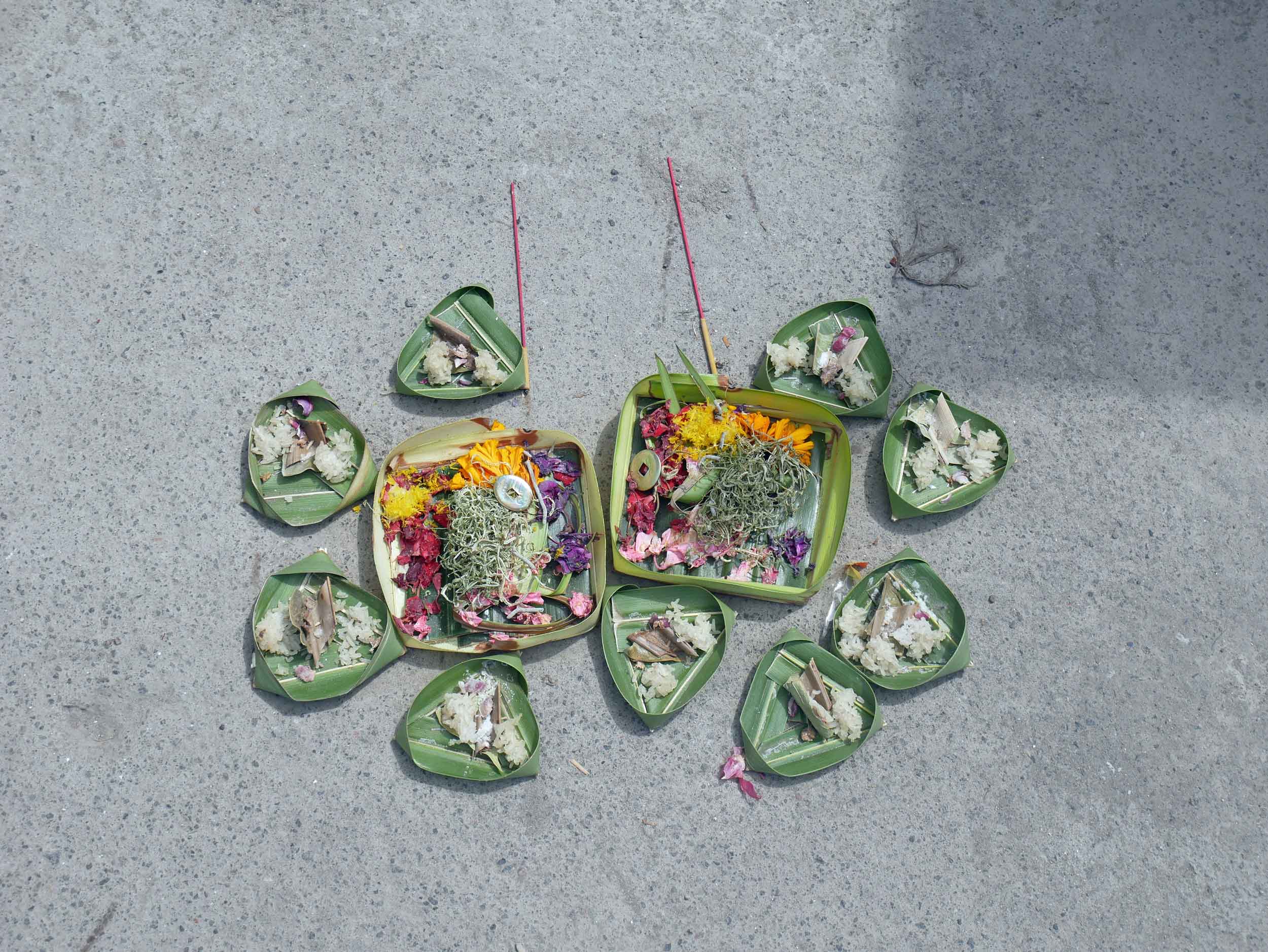

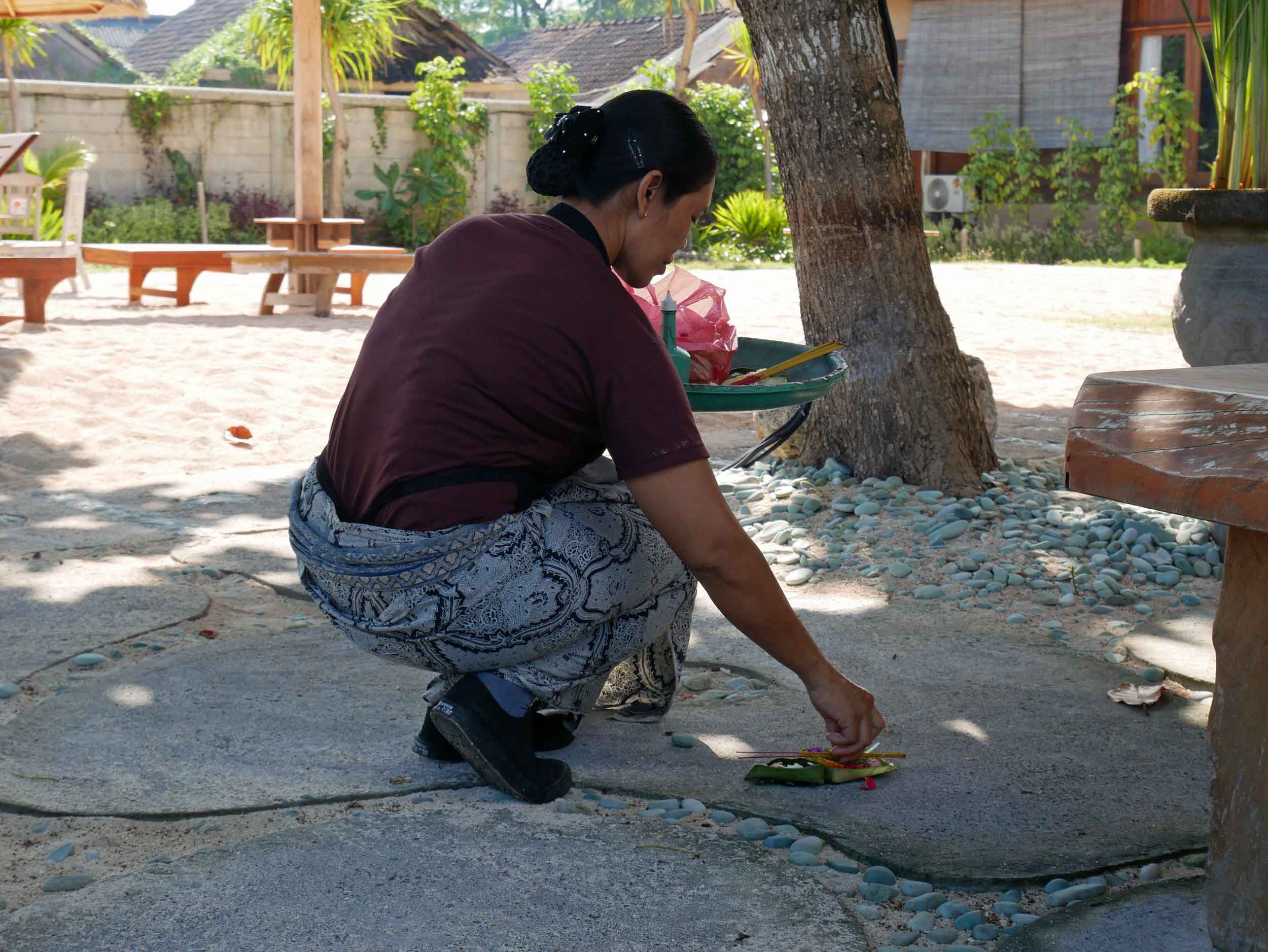
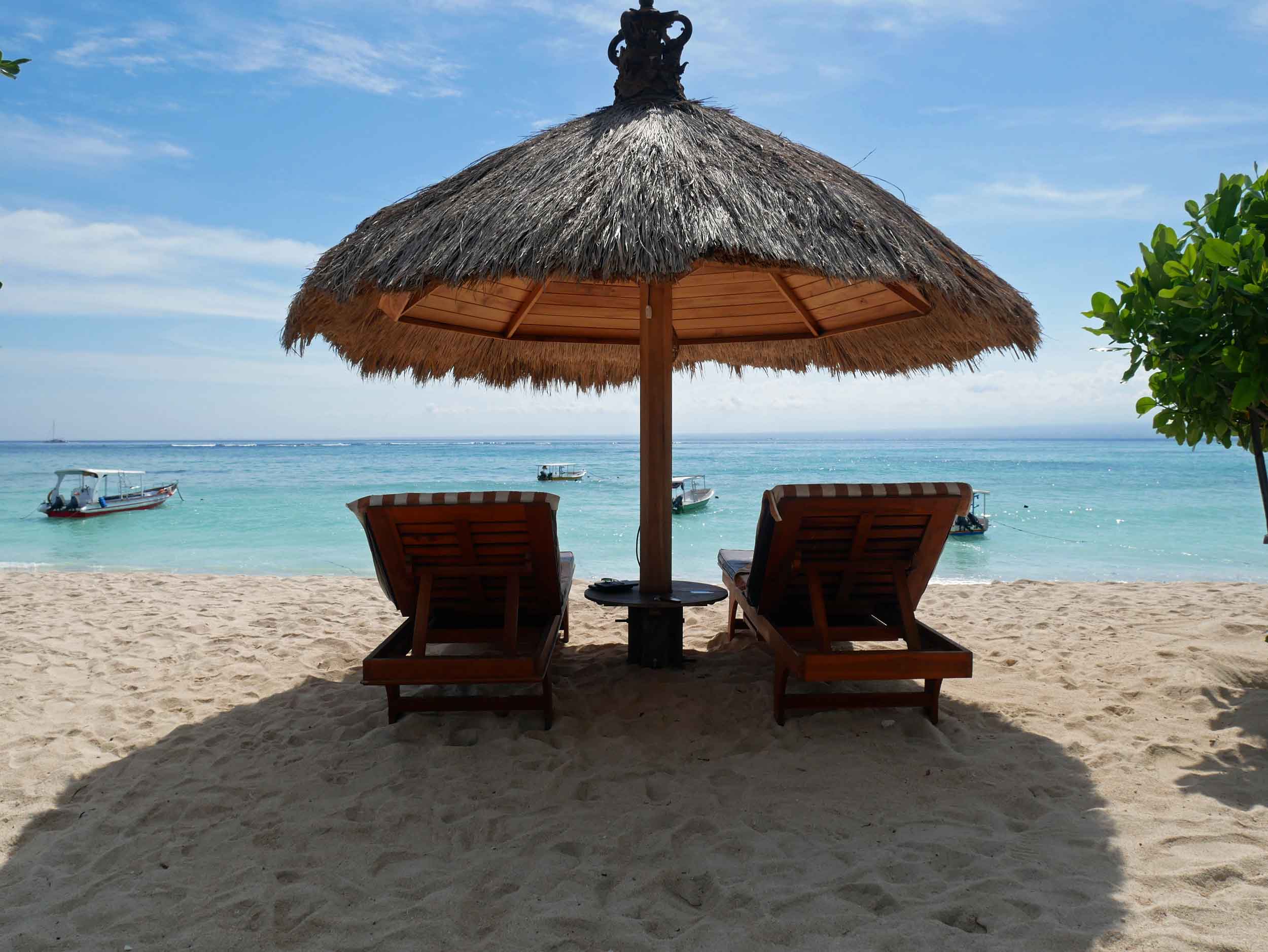

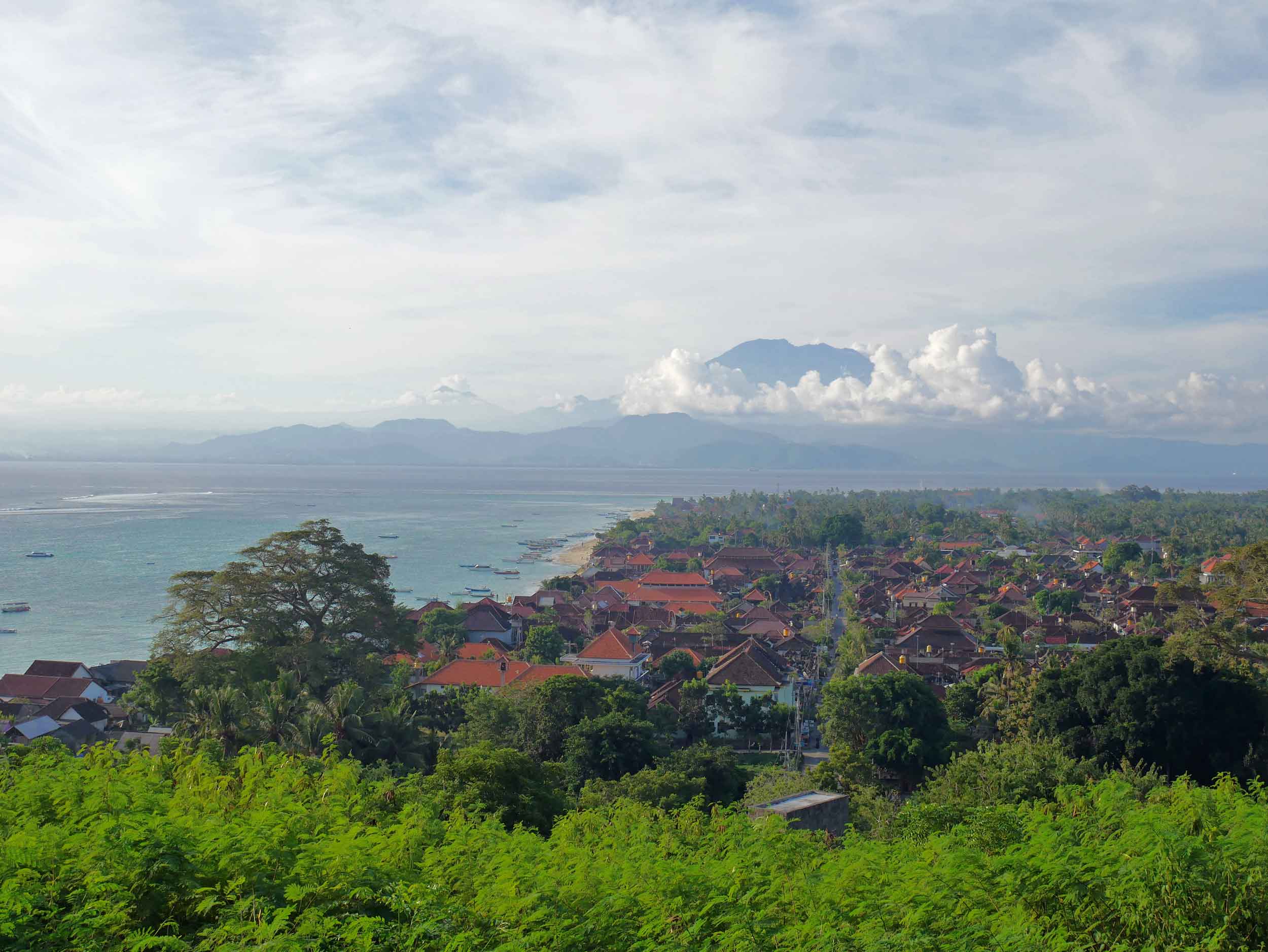
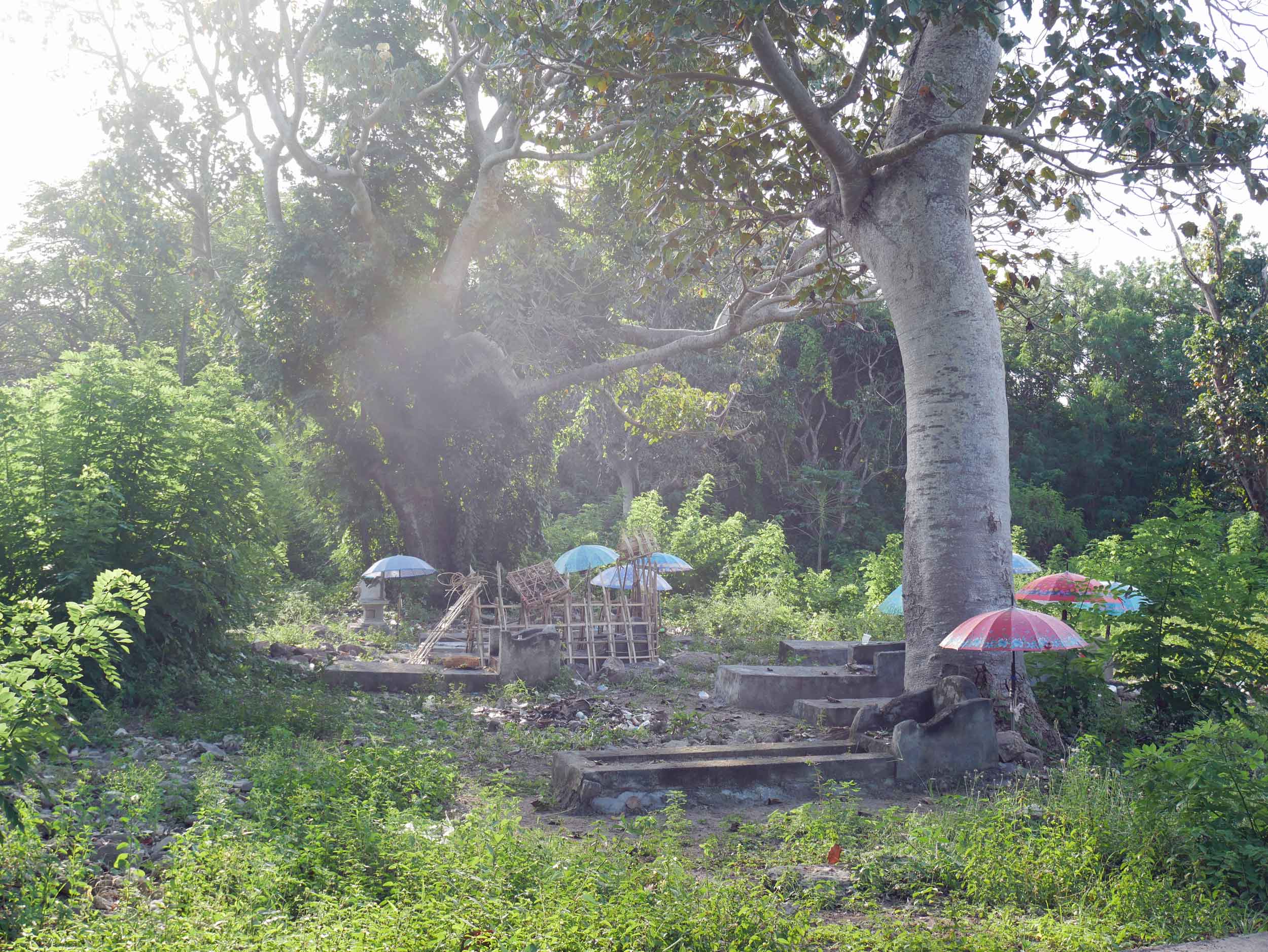
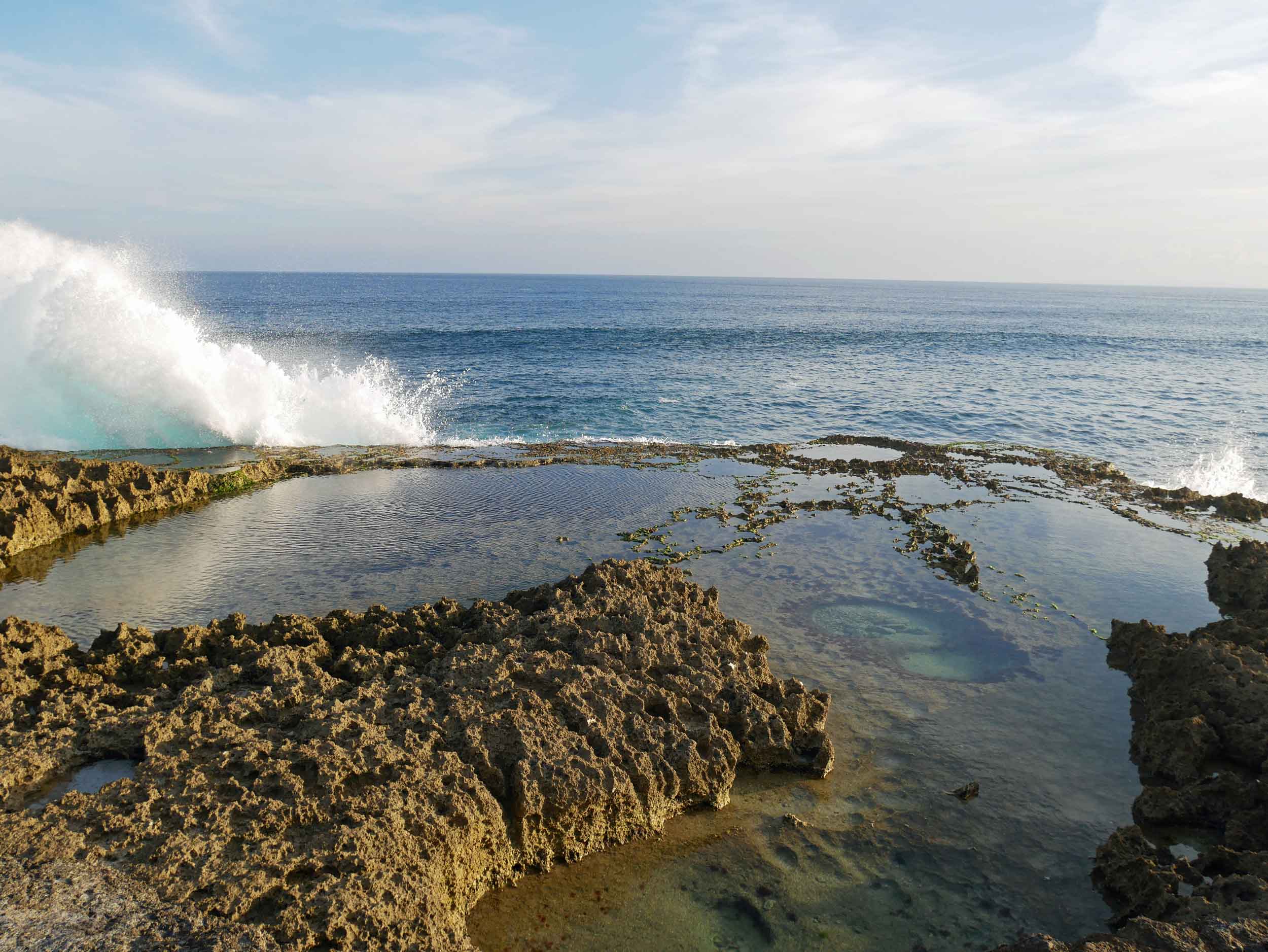
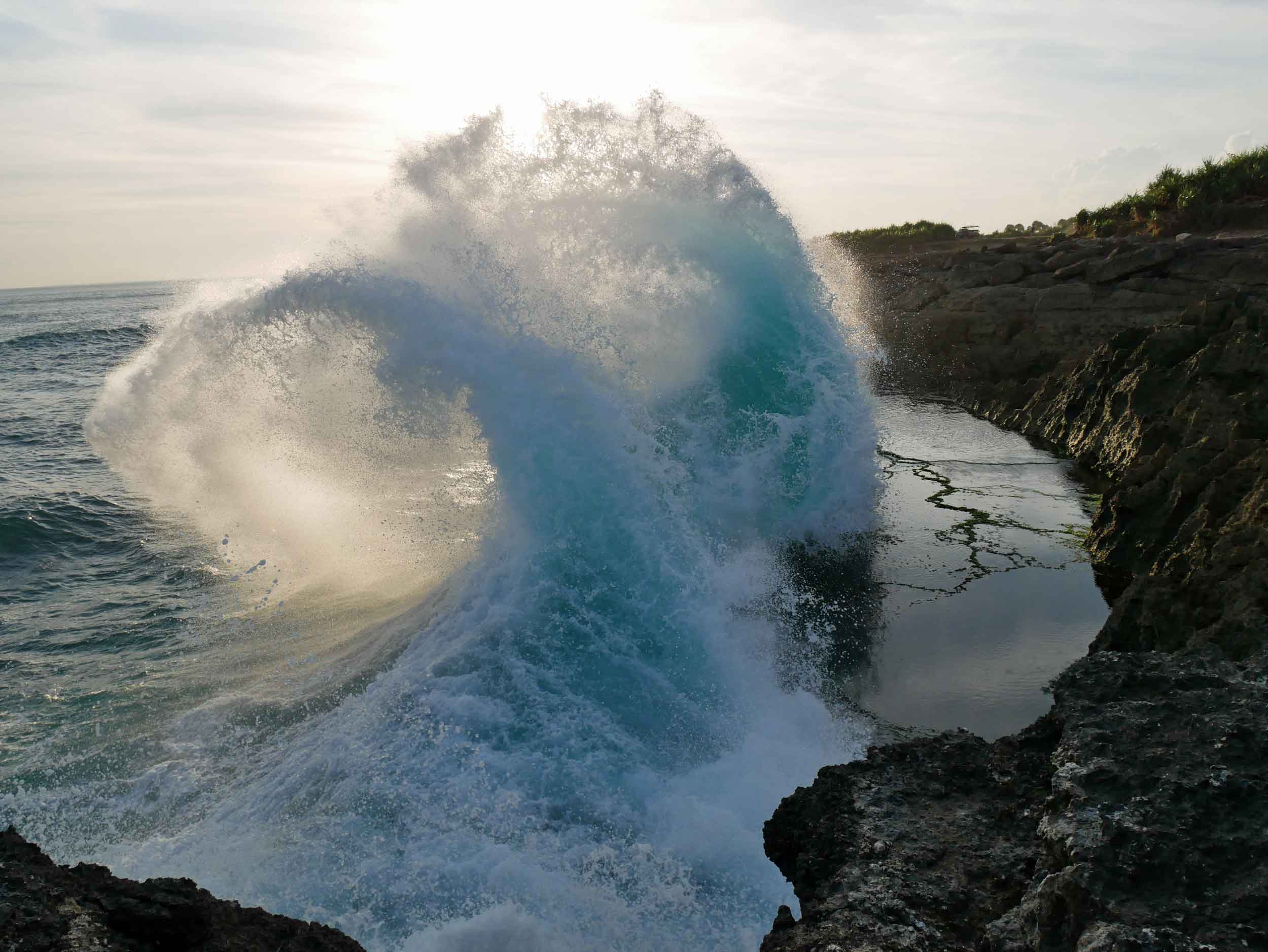
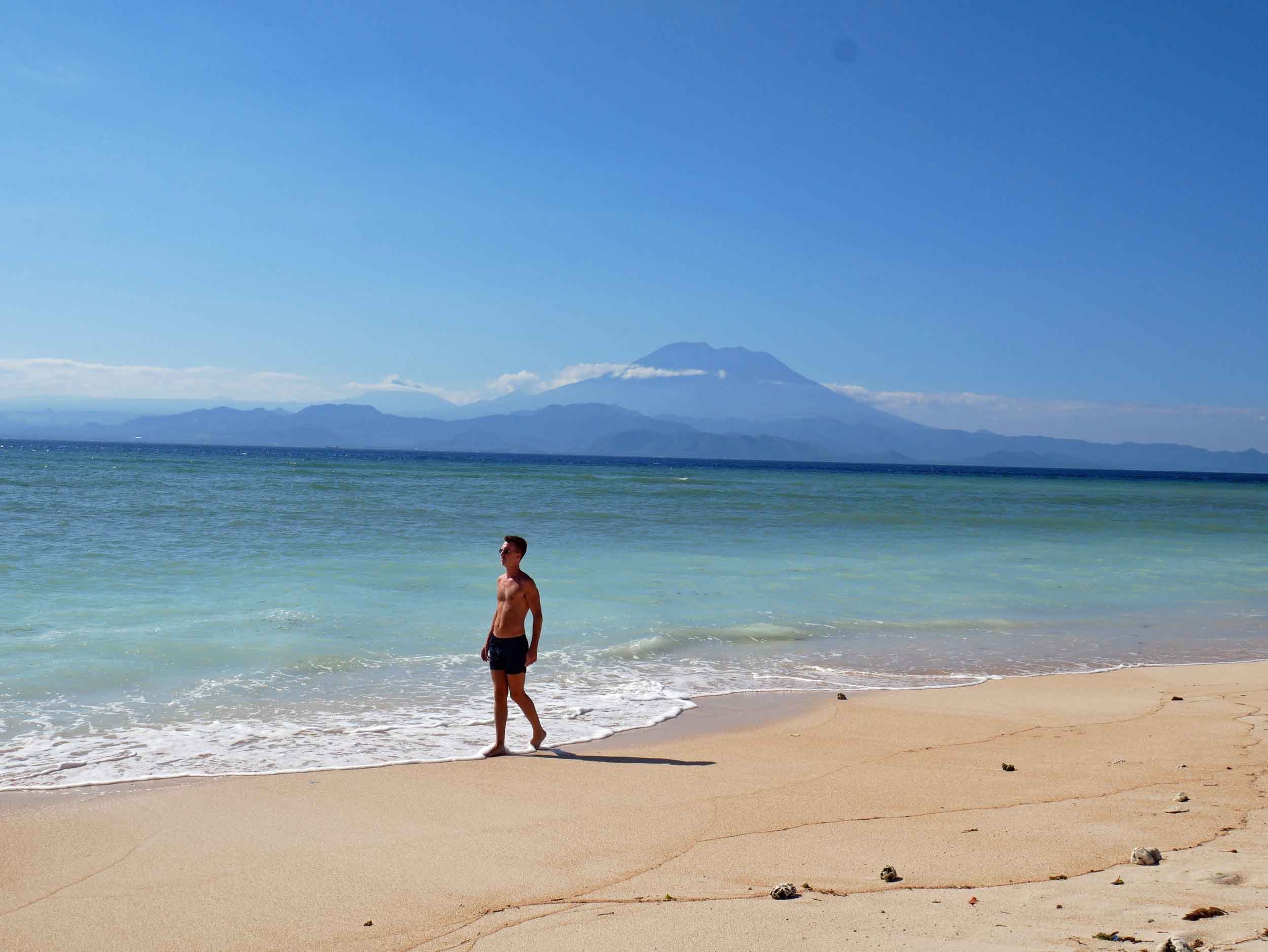
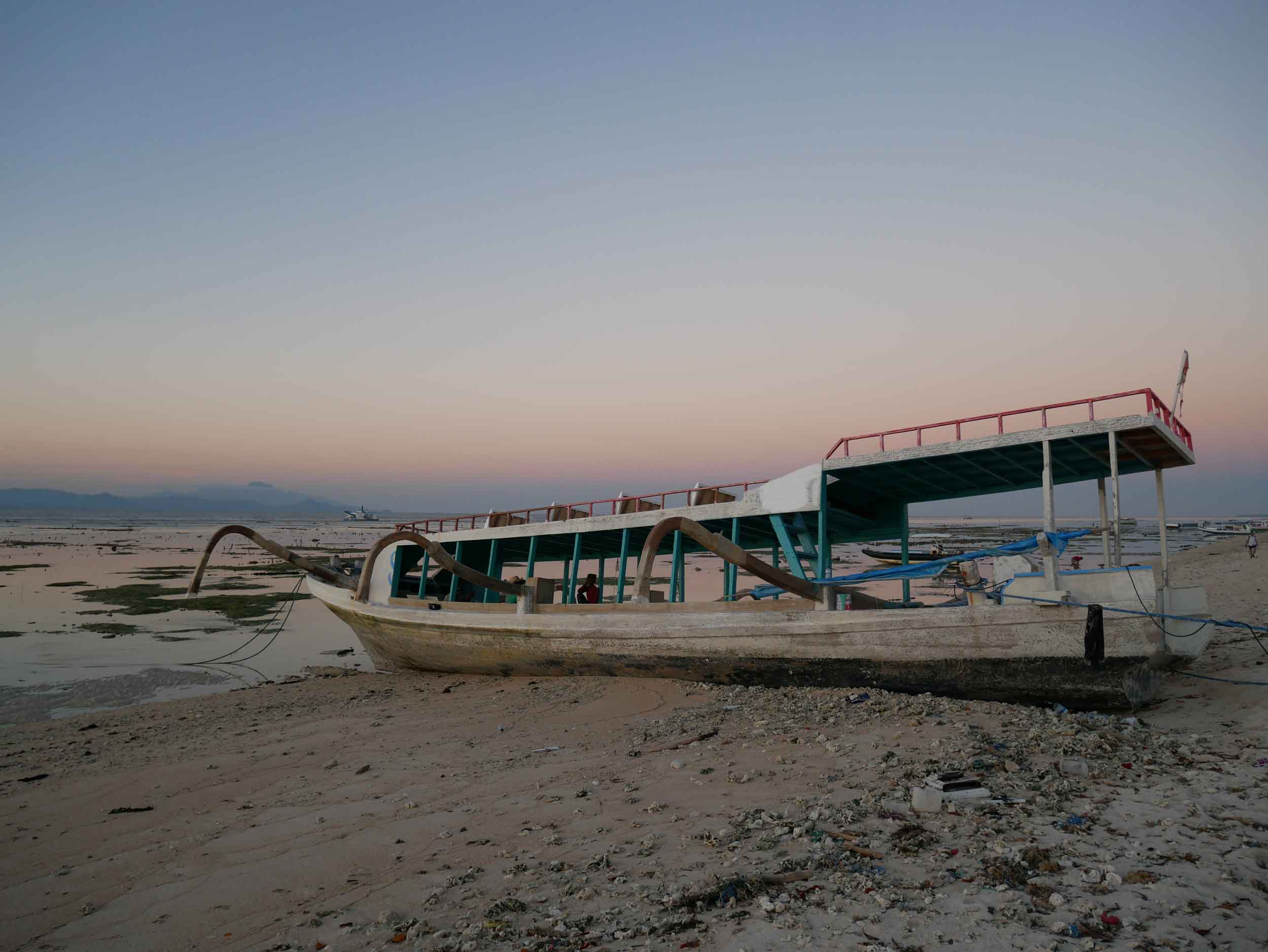
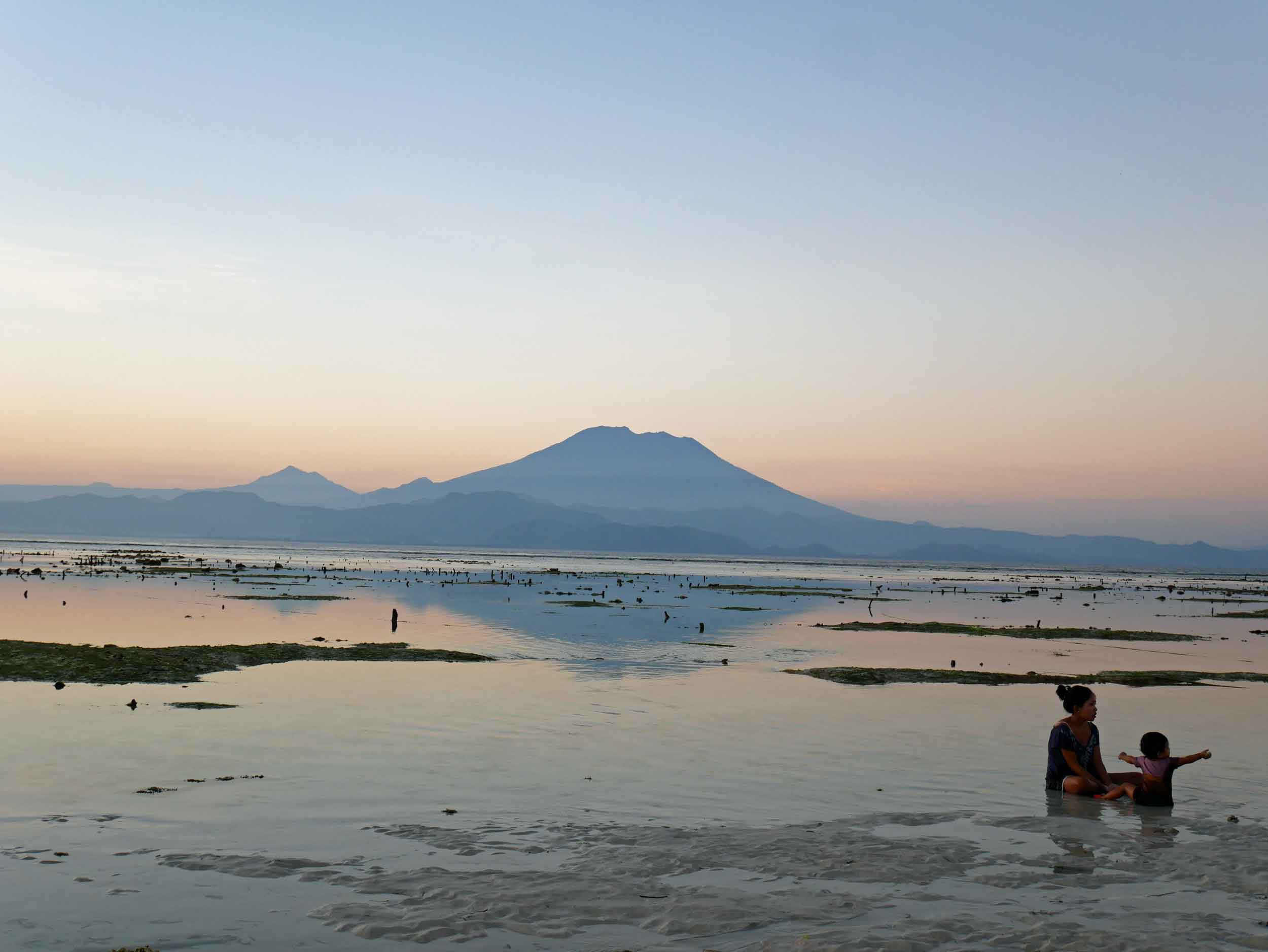
For us, however, Lembongan wasn’t all chanting and downward dogs, for there was much to explore, including dramatic coastline cliffs and vibrant coral reefs teeming with life. We spent one afternoon zipping around the island on motorbikes, taking in the powerful, surging waves at Devil’s Tear and Dream Beach and watching sunset from the cove of Mushroom Bay. The next morning, we set out early with Captain Ketut and two other tourists—an American couple living in Vietnam and obsessed with goings-on under the sea—for a snorkeling tour around the island. Because of its positioning, Indonesia is infamous for strong ocean currents, particularly around Bali, but neither of us quite understood the water’s power until our captain dropped us at our first stop, popular Mangrove Point, and pointing, said, “I’ll pick you up down there,” an area nearly a kilometre away where a few other boats had anchored.
We looked at one another and then our boat mates with dropped jaws before shrugging off the boat’s side to be wowed by what Martin could only describe as a “conveyor belt of fish.” Once submerged, all we really had to do was float as if gliding through space, taking in the countless exotic and flamboyant fish who were swimming against the current that was now forcefully taking us toward our boat. We were able to catch our breath (and our wits) as we sped around the island to our second stop, Mantaray Bay, where the water was much deeper (and colder) and where after one failed attempt, we soon managed to spot and trail three car-sized mantas who were gracefully and gently grazing along the ocean’s floor with ease. After hurriedly swimming to keep pace with these magnificent creatures, we finished up our tour at Crystal Bay, where the water was calmer and shallower, allowing for a more relaxed discovery of the colorful coral and underwater life, including several shy sea turtles.
Coming up for (Gili) Air
As our few days on charming Nusa Lembongan came to a close, the only thing allowing us to move on was the knowledge of life on another dreamy island nearby. To do so, we had to actually leave Bali (via speed boat) and enter Lombok province, which is home to the picturesque Gili Islands, a group of three tiny islets just off the northwest corner of the coast. We opted for Gili Air, the closest to the Lombok mainland and a sort of “Goldilocks” of the Gilis—not the packed party-scene of Gili Trawangan but with more offerings than deserted Gili Meno. Make no mistake, Gili Air still felt remote with no cars allowed on the island and nary a motorbike within earshot. Instead, locals and tourists alike either walked or cycled, or for those with heavier loads, the island offered old-world horse and buggy. Because of these restrictions, Gili Air was exceptionally clean and quiet with only the occasional crow of a rooster or the booming Islamic call to prayer—a typical sound throughout Indonesia, with the exception of Hindu Bali—overpowering the relaxing rustle of palms in the island breeze.
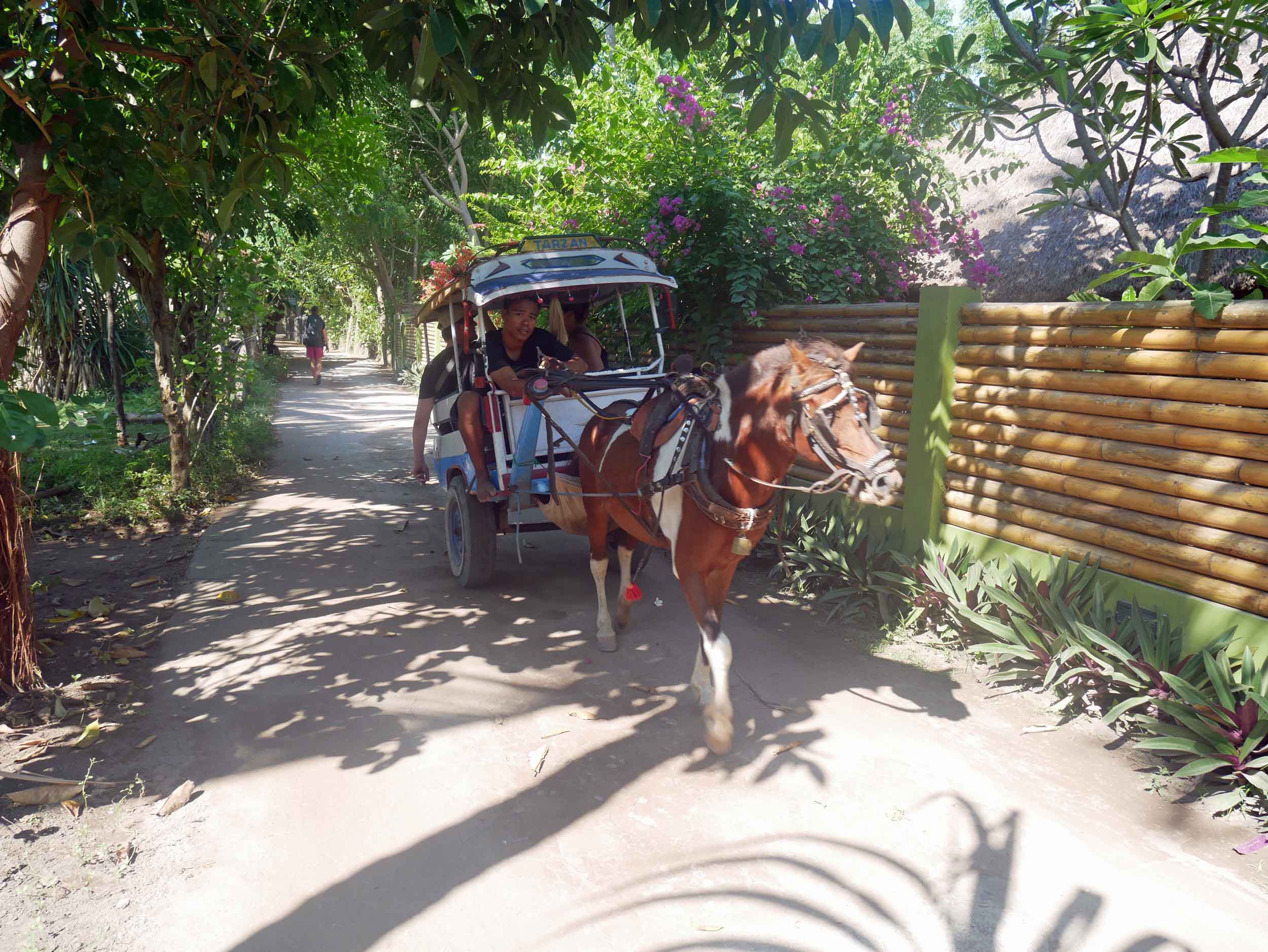



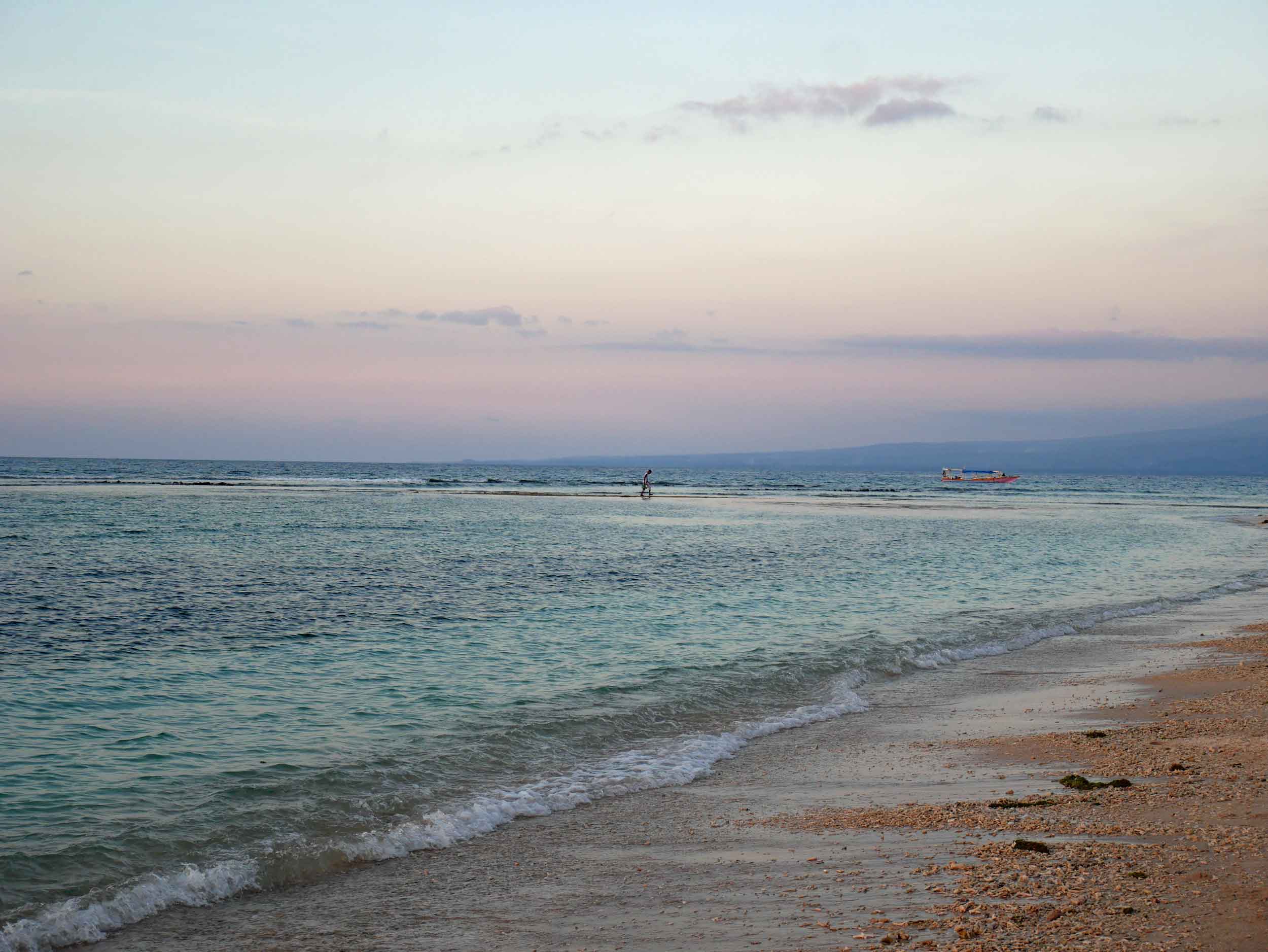
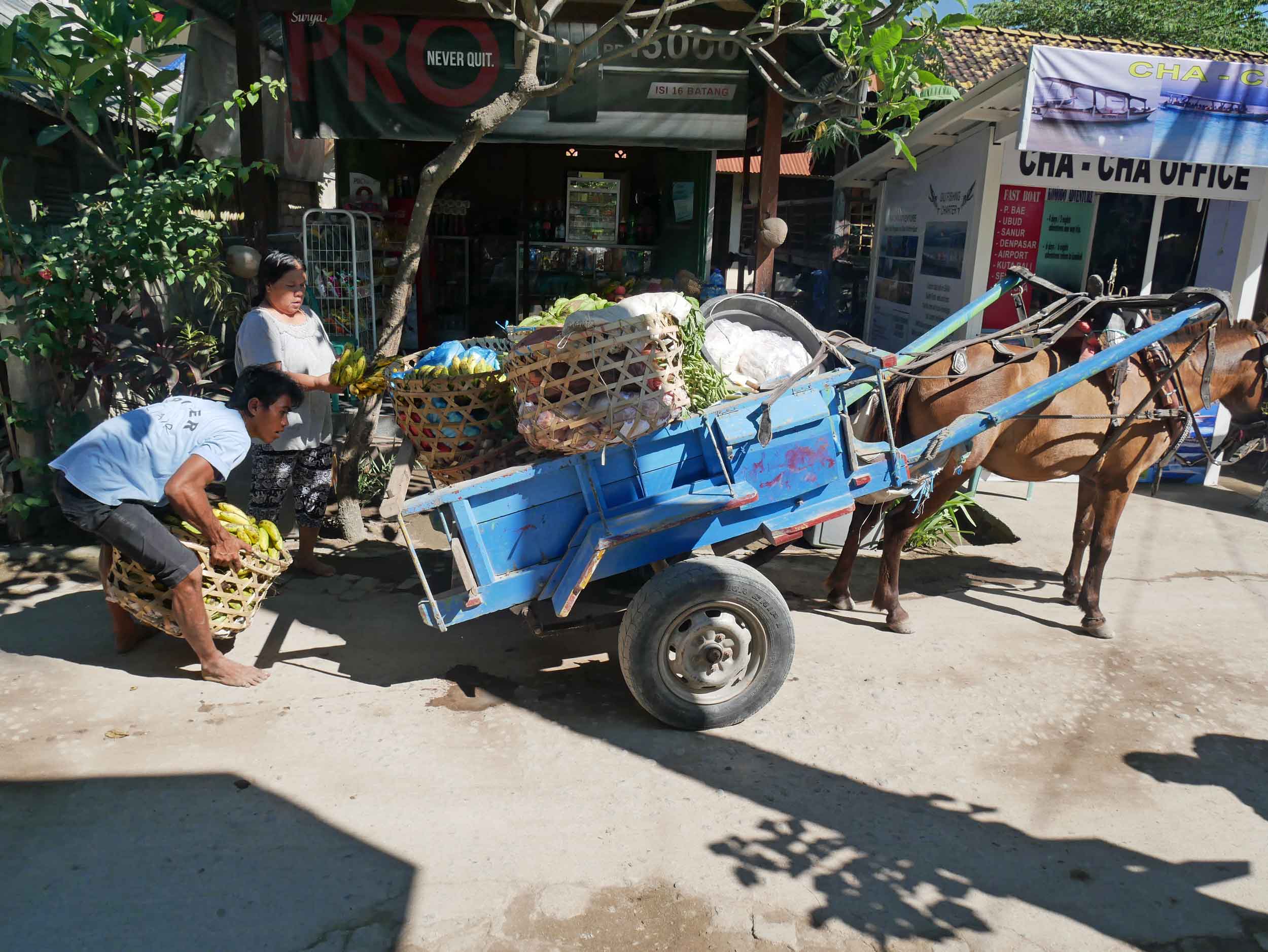
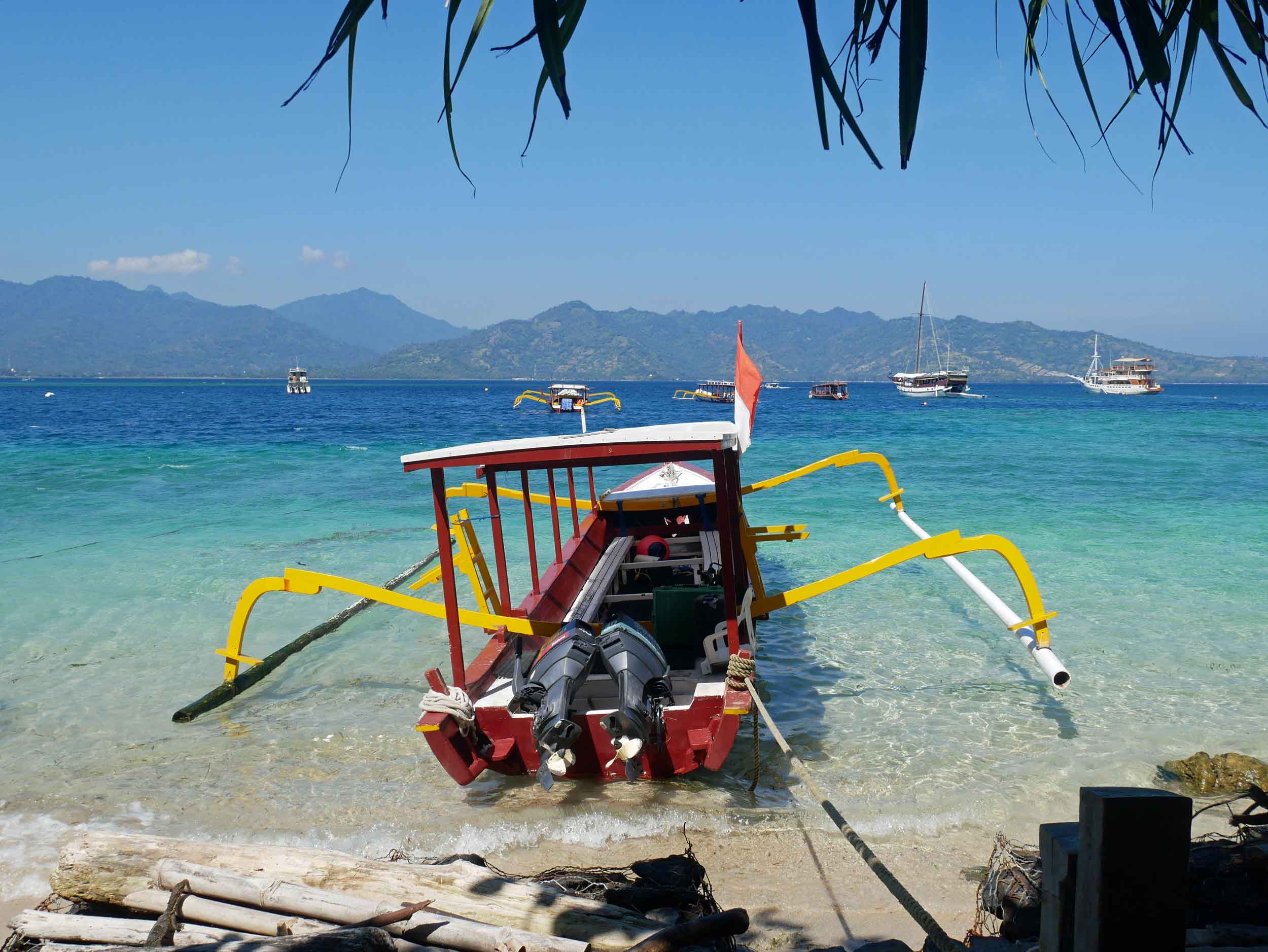
While we explored Lembongan, here on Gili Air we really rested, essentially tracing a triangle-shaped route day after day from our little hotel to yoga—either at H20 or Mandala Blue—and then down the lane to the hotel’s beach club where we would lounge on sunbeds under a netting of shade, dipping in the neon-blue water to beat the heat. The sandy footpath the encircles the entire island takes about 45-minutes to complete, which we did one late afternoon on bicycle, stopping at Mexican Kitchen, a Tex-mex beach bar, for tacos as the sun began to set behind Mount Agung, still visible from this remote distance. Another evening, we chose to walk the path (given that we had found some parts too loose with sand to easily steer a bicycle across) for dinner at hipster Pacha Mama, an organic whole-foods café that served favorites like seaweed and red rice bowls, zucchini pasta with vegan pesto and dragonfruit raw cheesecake.
Back to Bali, Arriving to Amed
Leaving Gili Air, we took the two-hour ferry back to mainland Bali, landing on the northeast shore near a strip of small fishing villages that are often collectively referred to as Amed. With the area’s black sand beaches and sky-high cliffs that rise out of the azure sea, dotted with flowering bougainvillea in vibrant shades of pinks and reds, we felt as if we’d been transported to the famous coastlines of Hawaii. Here, we stayed at Meditasi hotel, owned by a third-generation medicine man, that became well-known to travelers after hosting a famous visitor, the author Elizabeth Gilbert, who brought Bali to the masses through her now iconic memoir (and subsequent major motion picture) Eat, Pray, Love. As legend has it, after her best-selling book was published, Liz returned to Bali and stayed in one of Meditasi’s stand-alone beach huts, making her way through the hotel’s menu of herbal Balinese medicinal teas and practicing yoga and meditation on the front lawn facing the indigo ocean.
We, too, sipped on those healing teas as we rested on oversized pillows and stared through the large opening of the hotel’s gate with smiling red Buddha perched on top onto the blue and white-foam waves crashing against the ebony sand. One afternoon, we were met by the owner’s wife, a bursting woman—both physically and spiritually—who took us through a one-of-a-kind yoga session. We couldn’t help but grin at one another as her limited English didn’t so much teach but simply directed us to observe and then imitate her movements (yet we somehow did alright). We ended the practice by making monkey faces—blowing out our cheeks and opening our eyes wide—to clear our chakras, followed by a round of laughing yoga, where our mock giggles soon turned into full-on cackling hilarity. It was by far the most unique yoga class we’d experienced so far on the trip and at the same time, one of the most healing.
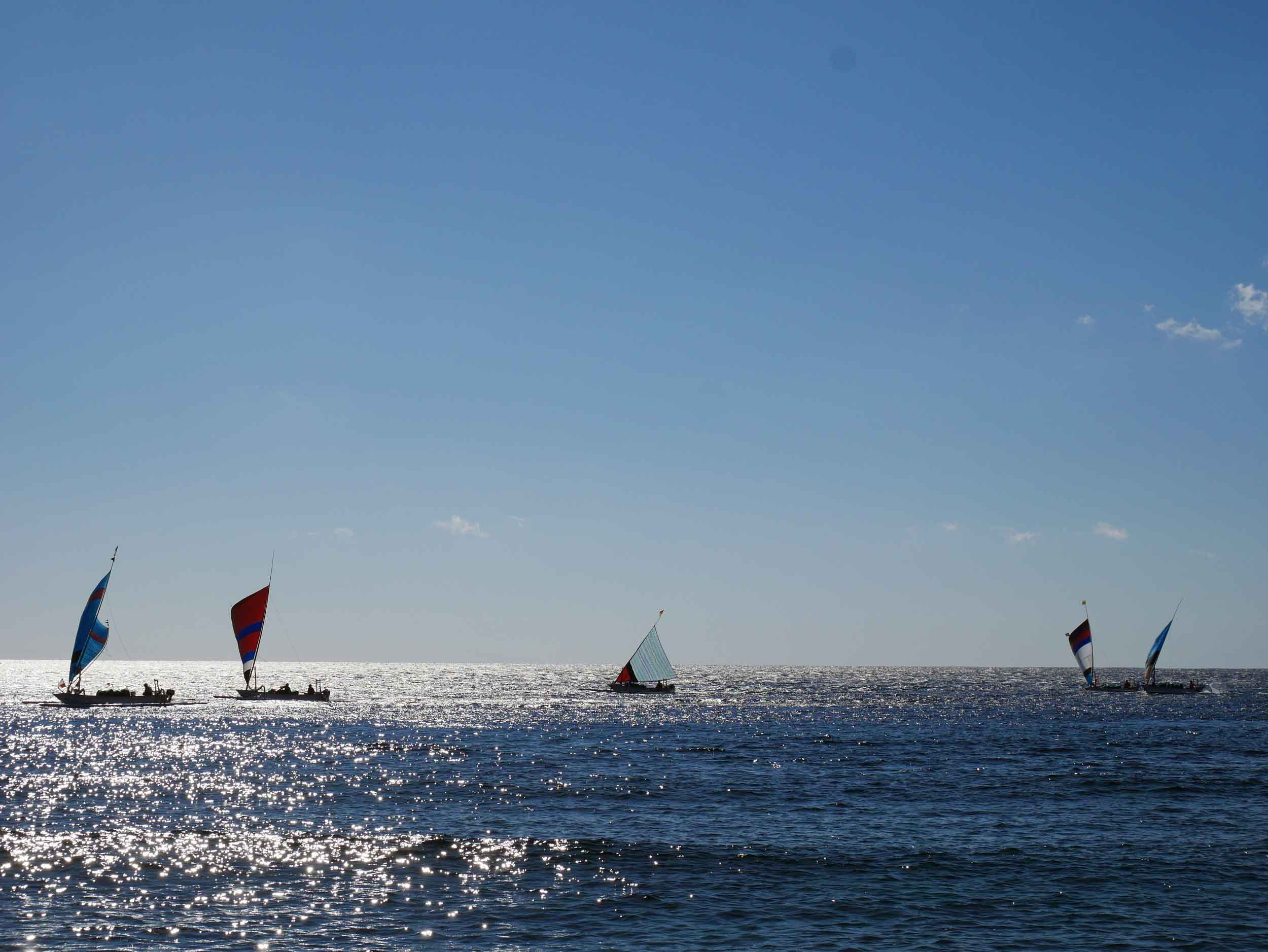

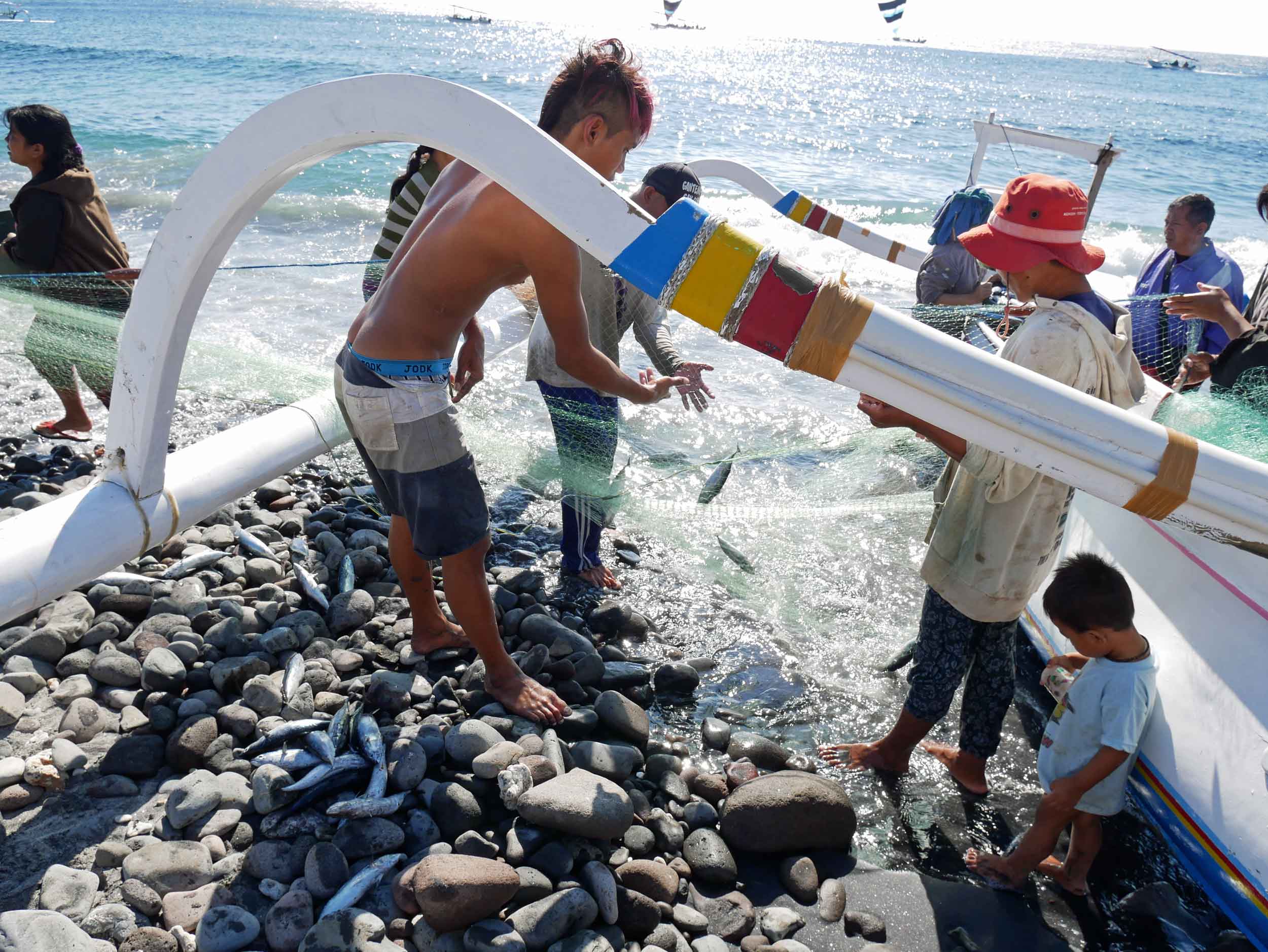
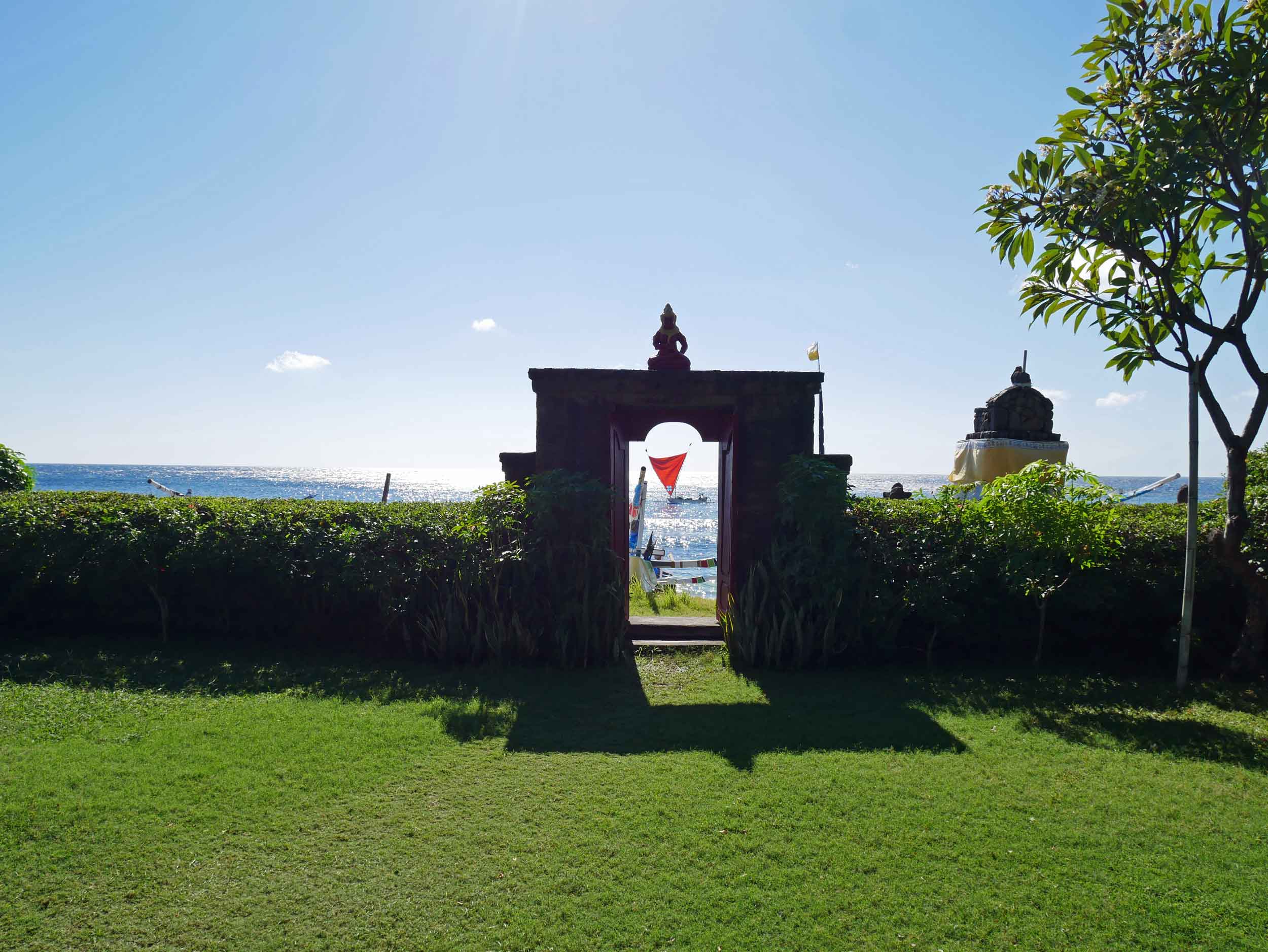
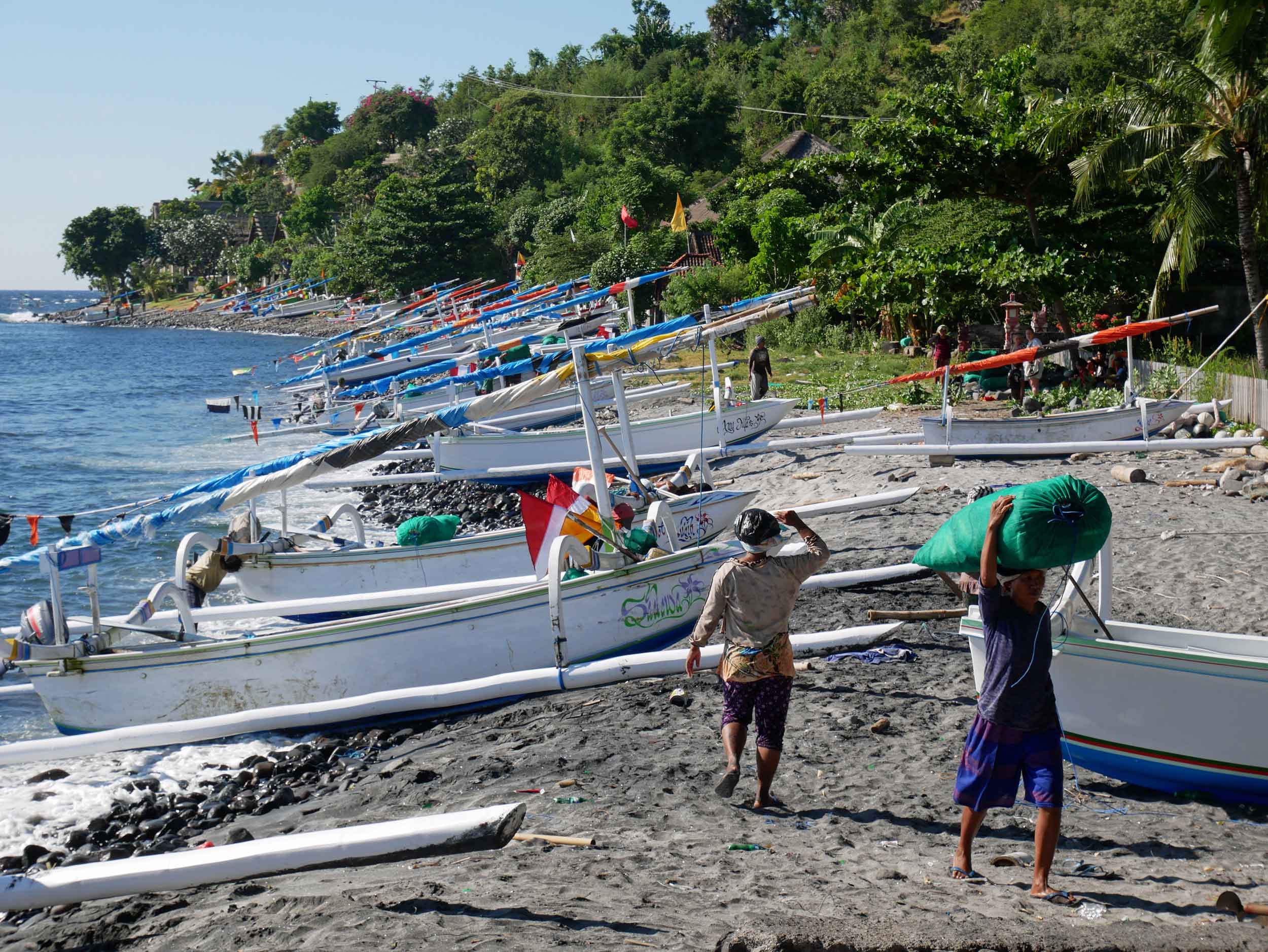
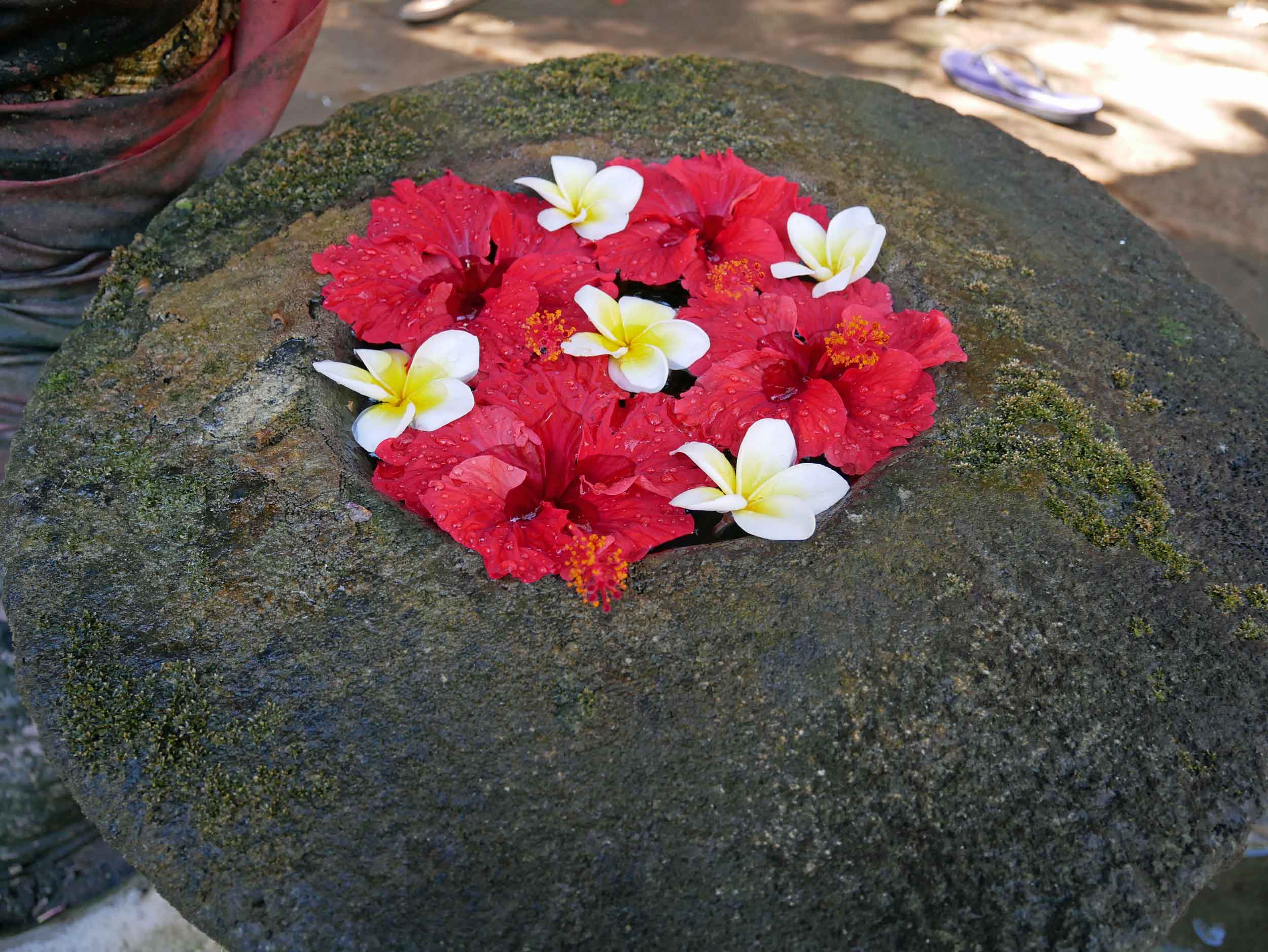
The rest of our time in Amed was spent lounging on the large bed (no, really, a four-poster complete with pillows and duvet) on our bungalow’s porch, snorkeling in the ocean and warming up under the sun on the warm, charcoal-colored beach, and eating local Balinese food cooked by our jovial yoga instructor. Meditasi was a calm and contemplative place with simple accommodation—large thatched walls that rolled back to open up the entire bungalow to the sea air, outdoor bathroom with a shower fabricated from a dried bamboo stalk—but it was unlike anywhere we’d been so far on the journey.
Stopping in Scenic Sidemen
As we started to make our way to the island center, we stopped for a couple nights in Sidemen, a small valley just off the main road in the hills of eastern Bali and known for its verdant rice terraces. Like Amed, Sidemen has recently emerged as a new destination just off the beaten tourist path, and the locals are still living very simple and traditional ways of Balinese life. On our first evening, as we walked the dusty streets through the village, we heard the booming sounds of temple music being practiced at dusk (we would continue to hear those pounding drums and melodic tones echoing through the valley well into dark). We chose a small lane that would take us down to the Unda River, when suddenly young boys with wet heads and towels draped around their shoulders zoomed passed us on motorbikes and small families and couples going our direction sped by. A bit perplexed by the unexpected “rush-hour” traffic, we quickly realized they must be taking daily baths in the water. We soon arrived to a bright yellow bridge that crosses the river, stumbling onto an Eden-like scene: nude children frolicked in the rushing waters, barely avoiding fathers in sarongs who tried to hold them down for their nightly scrub, while bare-breasted mothers soaped up infants and brushed the teeth of little ones. Free of any shame or embarrassment, it was beautiful to witness this evening ritual (and social engagement, of sorts) for a few brief moments.
That night as we slept, we realized why Sidemen is so lush and verdant as roaring, soaking rain showers descended on the valley, beating down on the thatched roof of our bungalow and continuing well into morning. When the rain finally cleared, we took a midday walk through the swaying fields of rice, taking in the simple beauty of these nourishing grains and the effects of water on the young plants, which seemingly grew more than a metre overnight. During our time here, it continued to rain off and on, something the locals said was unusual for the time of year, but whenever the sun would appear, we hopped into the hotel’s infinity pool for a swim, staring amazed into the terraced fields of green and yellow that surrounded us.
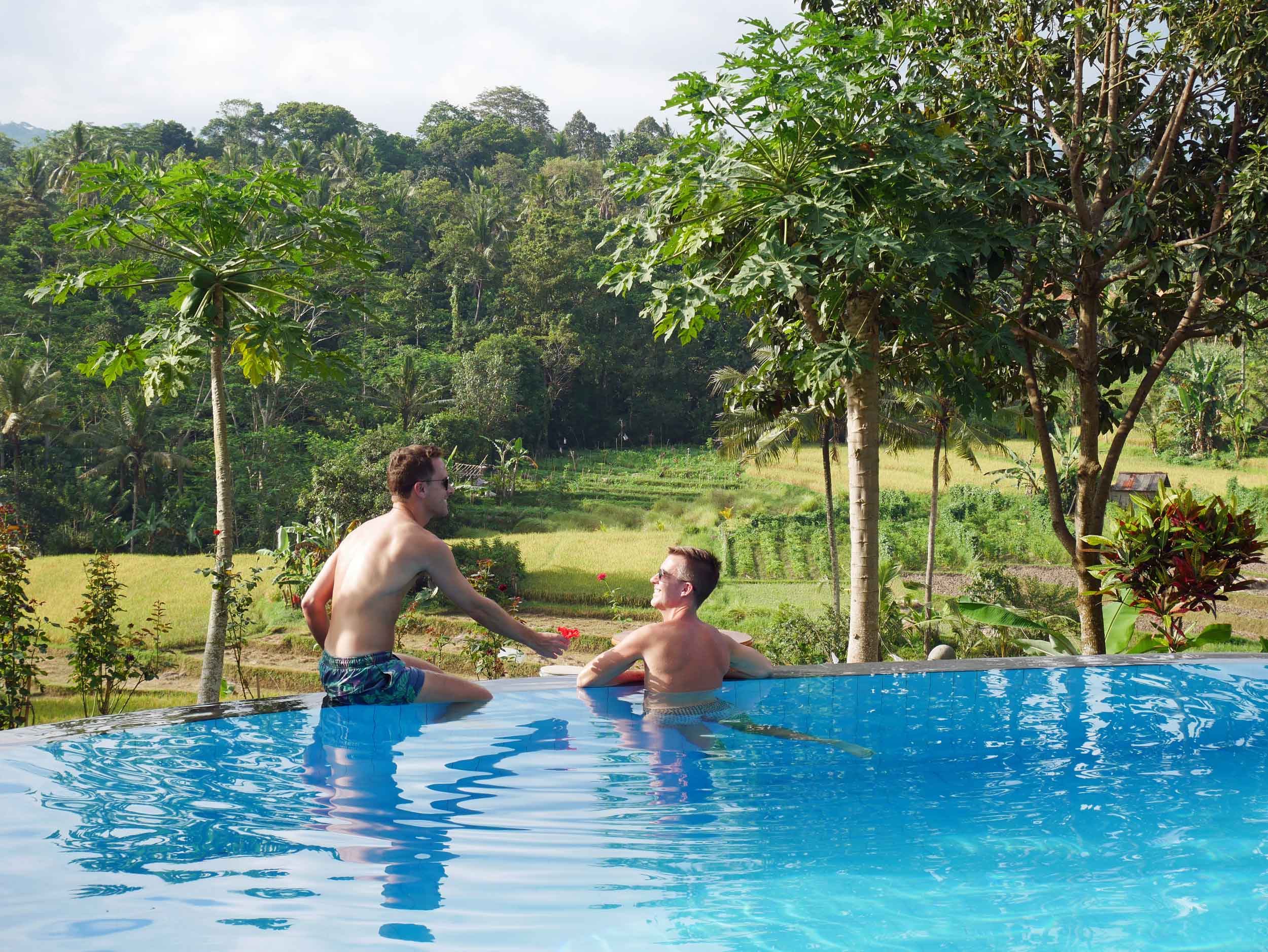
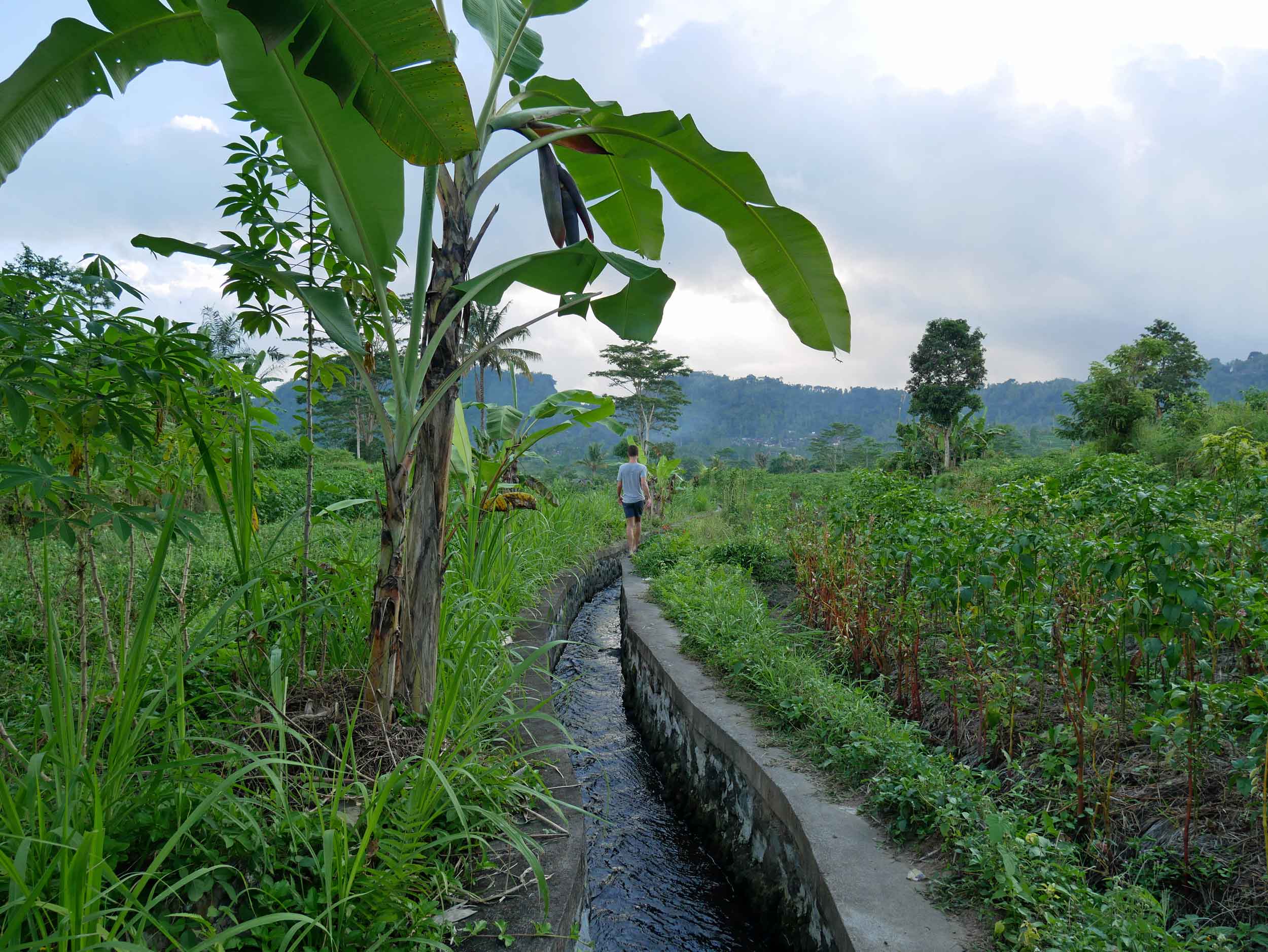
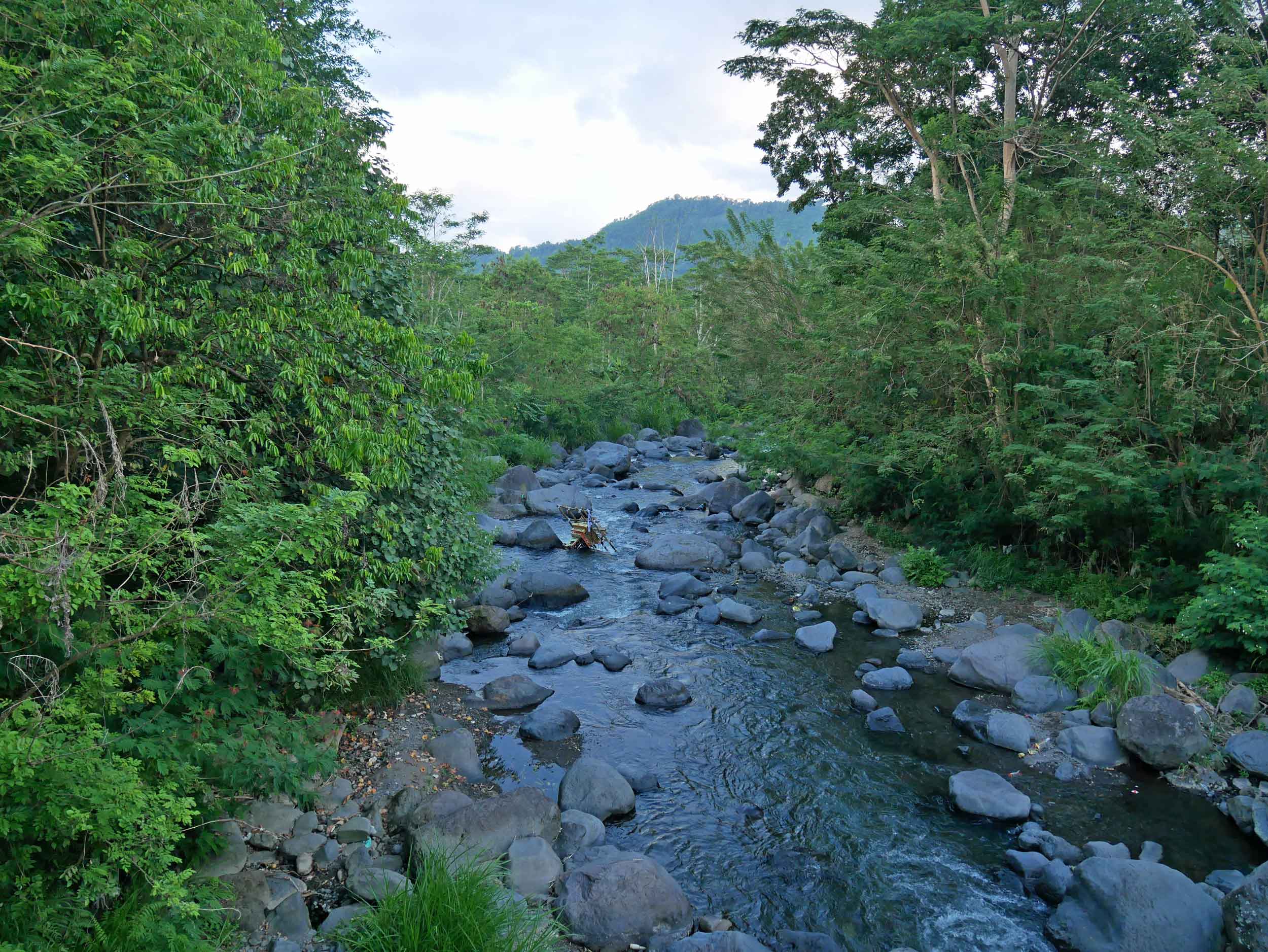



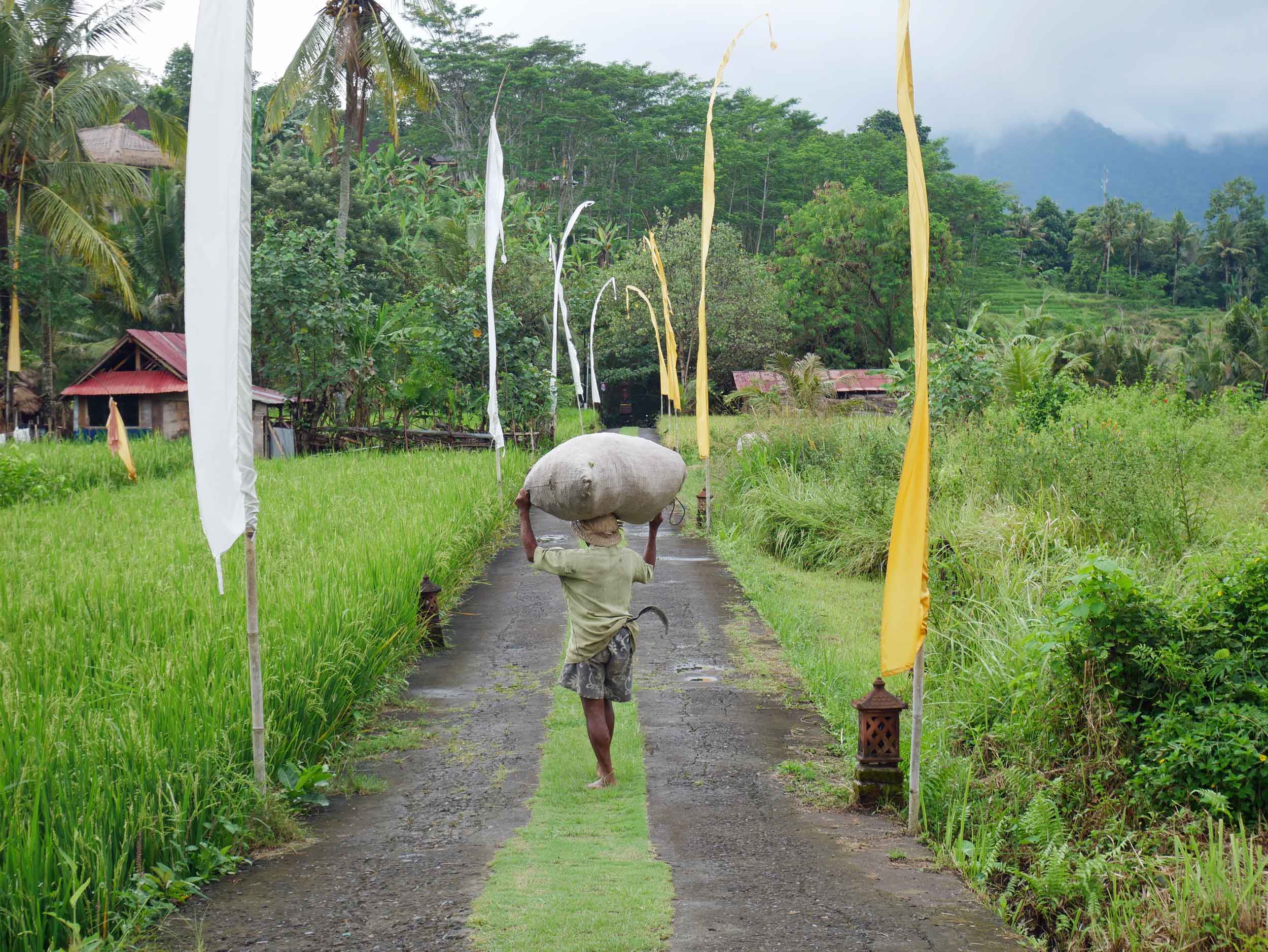


Nearing two weeks in the region, we would soon move to the mystic jungles of Bali’s center to settle down with friends for a period of peaceful renewal and restoration—socially, physically and spiritually—before moving on to explore other extraordinary sites around the Island of the Gods.
Check back soon for Part Two of our journey through Bali.
